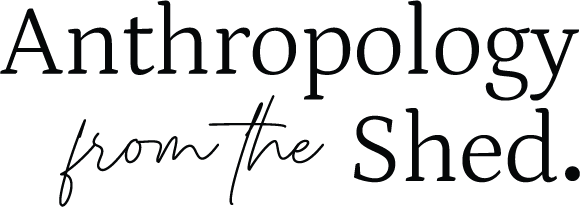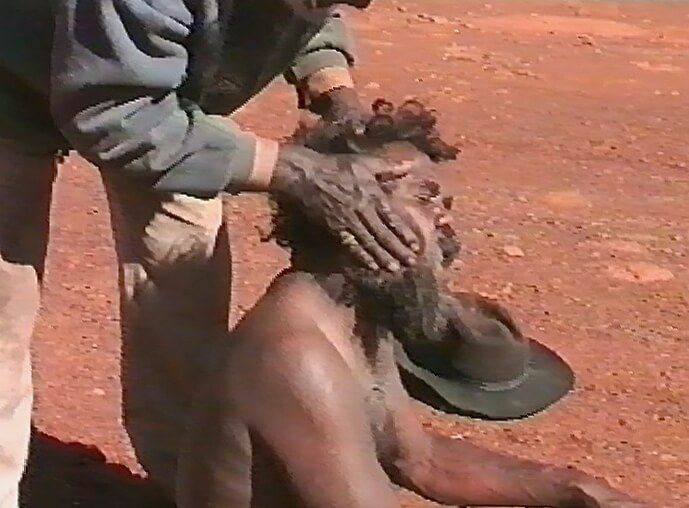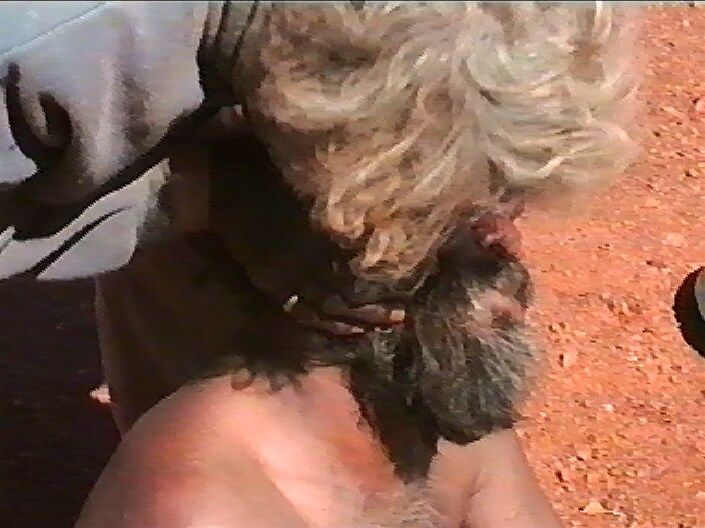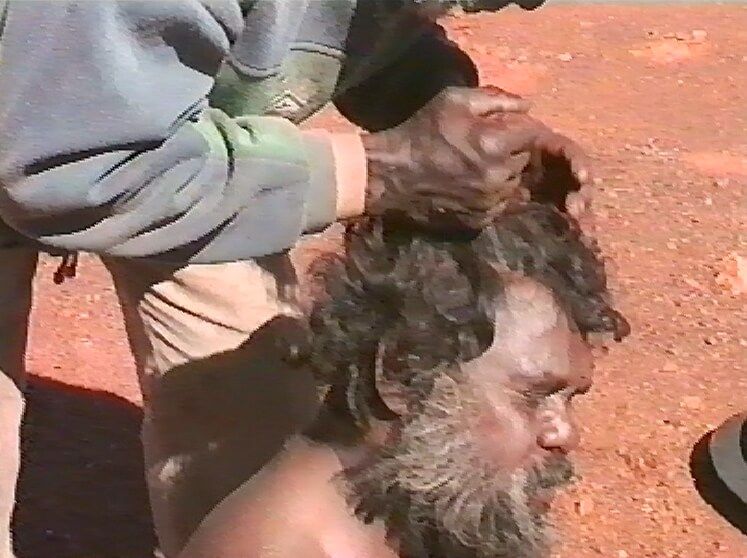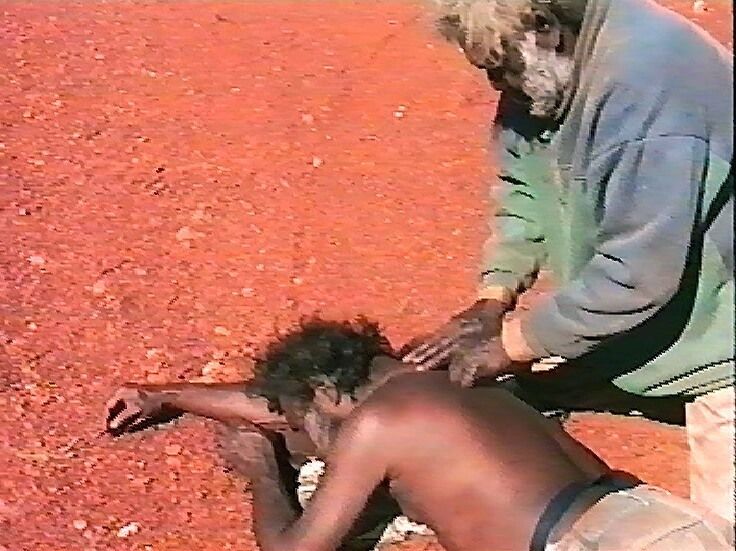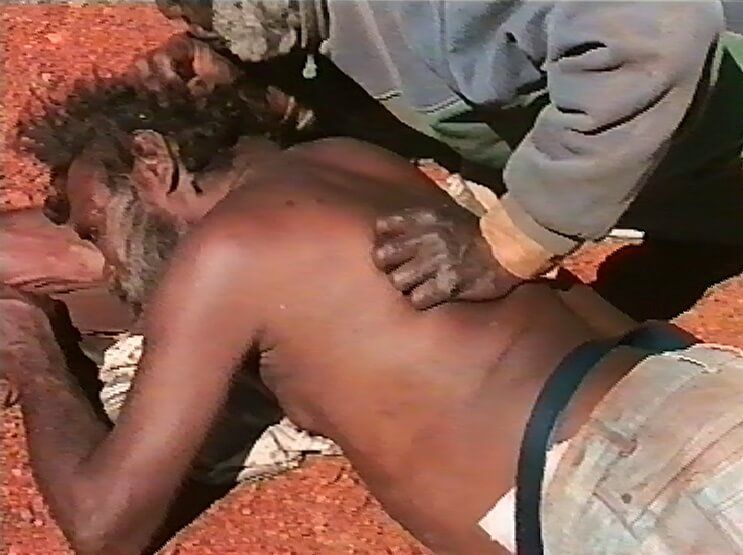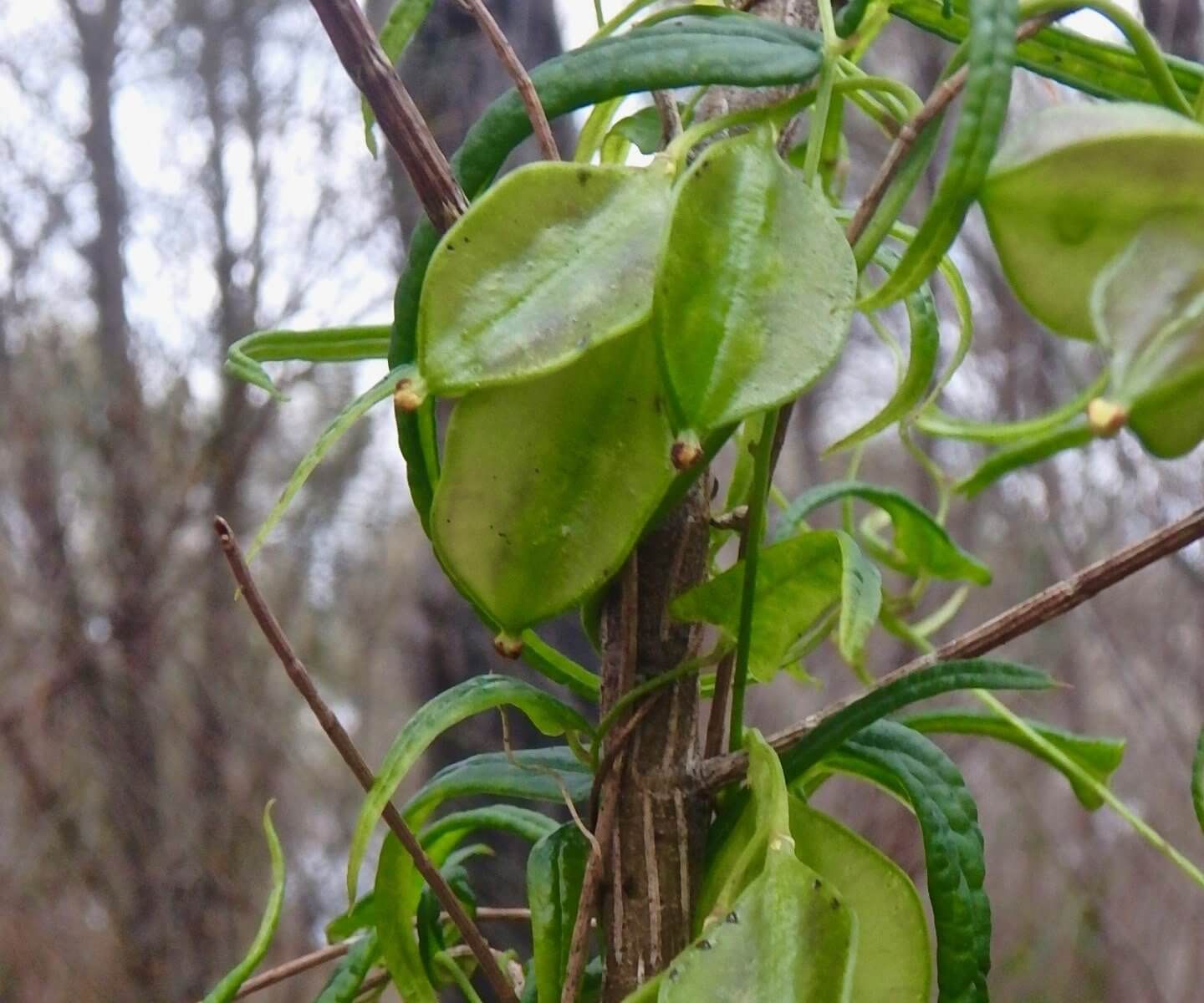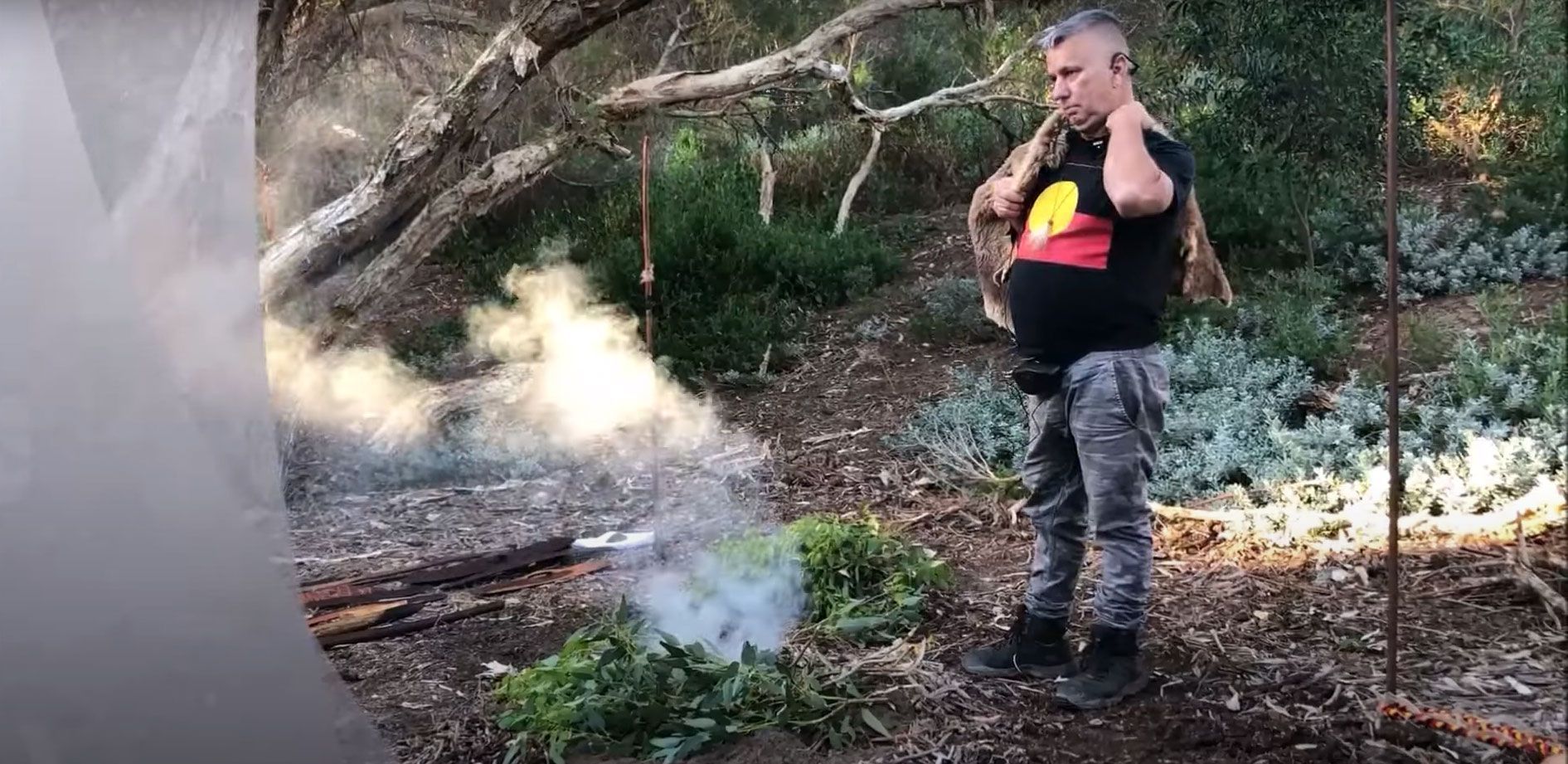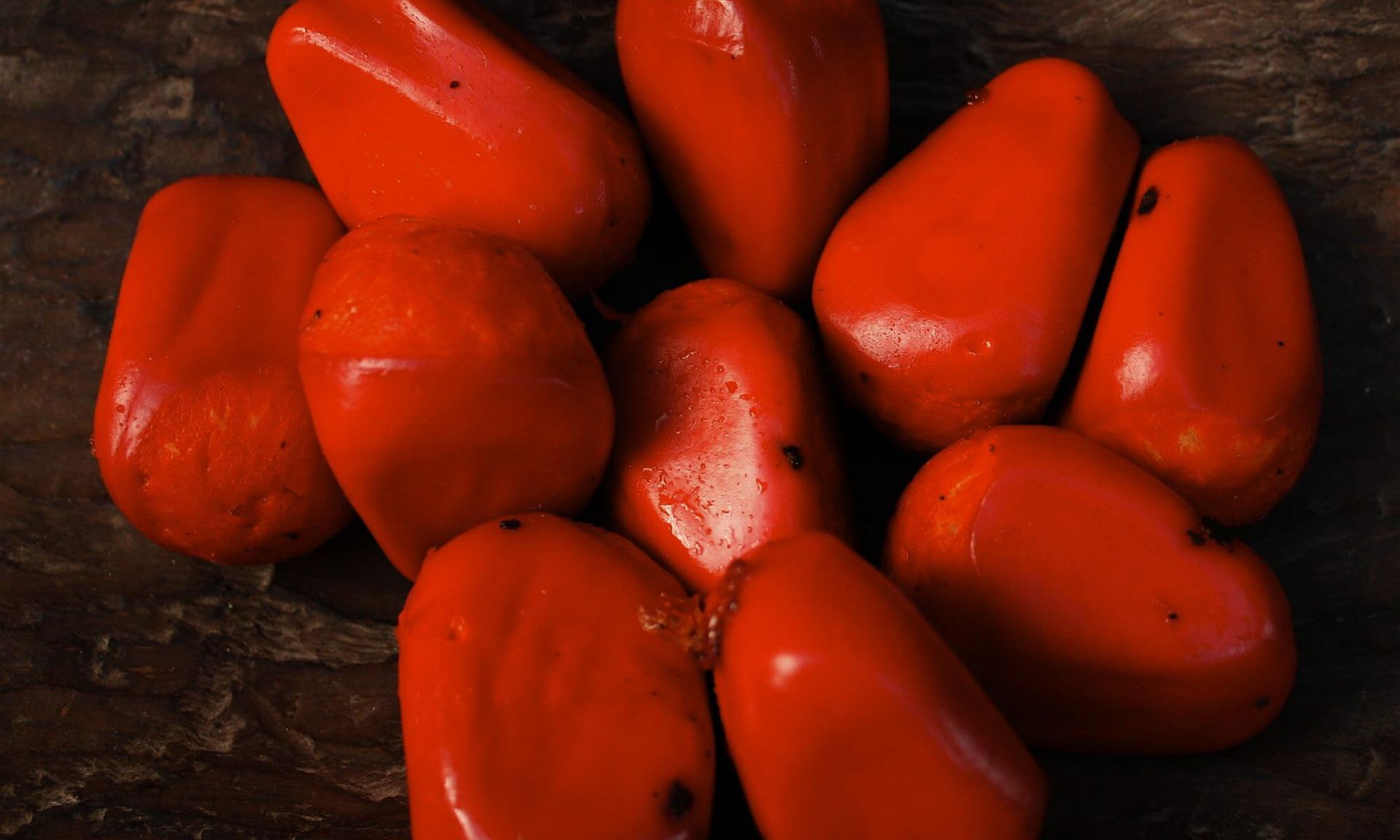Western Desert healing
This paper was prepared by anthropologist Ken Macintyre, Feburary 2009, based on field observations and information collected between 1973-1999 at Wiluna.
To the indigenous reader please be aware that this article may contain the names or images of persons who are deceased.
It has interested me ever since I first observed an Australian Desert Shaman performing a traditional massage to treat a patient who was suffering from severe neck pain, possibly the result of chronic arthritis. This was my first introduction to Western Desert healing. The anatomical locations on the patient’s body treated by the practitioner were reminiscent of the points that I had observed in the late 1970’s while studying shiatsu and acupressure in Japan. This made me reflect, did all ancient people at one time possess a knowledge of pressure point therapy? Could it be that rubbing and pressing the sore spots on the body was the earliest means of healing?
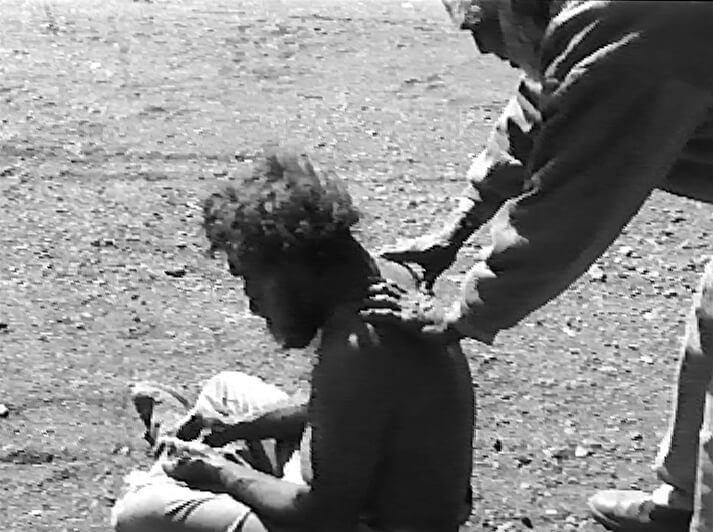
Since the discovery of Otzi, the 5,300 year old Copper Age mummified man found in the glacial ice of the southern Tyrol in Italy in 1991, there has been a radical rethink of the antiquity and origin of acupunture therapy as peculiarly Chinese. Crude tattoos identified on Otzi’s mummified body are believed by some experts to indicate the location of pain-relief acupunture points, possibly those used to treat chronic arthritis. Otzi’s skeletal remains did seem to suggest that he suffered from a form of arthritis in his lower back, leg and ankle.
This finding did not surprise me, as in traditional Aboriginal culture, as I had observed in the Western Desert of Western Australia, similar points were still being used in the treatment of a range of traditional conditions. Indigenous Australians are one of the longest continuing cultures in the world today with a prehistory that dates back tens of thousands of years.
The focus of this short article will consider the efficacy of traditional Aboriginal massage as a potent healing technique in the reduction of physical pain, stress and anxiety. Throughout the discussion I will try to demonstrate some of the similarities between traditional Aboriginal massage and what is known today as Chinese acupuncture/ acupressure point therapy.
Toothache (Katiti pika)
Traditional Western Desert toothache treatment resembles in many ways the pressure point techniques used in Chinese acupressure. As demonstrated here, the muscles of the jaw are thoroughly rubbed (nyutila) in a clockwise and then anti-clockwise movement in order to relax tension in the jaw. The mapantjara (or mapan) practitioner explained to me that this was to encourage cool fresh blood to circulate the area of pain.
Firm finger pressure (tjulku) is applied to the centre of the upper corner of the mouth (acupressure point ST4) and to the central hinge of the jaw (ST6). Pressure on these points is considerable and sustained until the jaw becomes numb and the pain subsides. A similar technique is used in Chinese acupressure to sedate the jaw as a means of pain relief.
To conclude the treatment, the side of the face and temple (pitilyira) are firmly massaged in a clockwise and then anticlockwise direction to promote a cooling circulation of the blood. The notions of hot/cold and cool/cooling are used by Aboriginal healers to describe the difference between the state of illness and wellbeing. When a person is ill (whether the origin of the illness is physical, magical or supernatural), they are regarded as being ‘hot.’ The aim of the healer is to achieve a cooling effect and bring the body back to equilibrium. The term ‘cold’ is used to denote a healthy person.
To prevent the pain from returning, the maban practitioner blows his cooling spirit breath onto the affected area. This is regarded as a potent medicine.
Headaches (Kata pika)
The practitioner rubs the temples (pitilyira) and forehead to stimulate circulation to the area where the patient feels pain. It is interesting to note that the forehead area being massaged by the mapantjara practitioner contains two salient points used in acupressure to alleviate head pain. These are known in Chinese acupressure as Tai Yang and GB14. The firm, circular rubbing movement demonstrated here is known in the Western Desert language as nyutila. It is a commonly used stroke employed in indigenous head massage.
Points on the midline between the nose and hairline are pressed firmly (tjulku) using the thumbs in an inwards and upwards direction. These points are located on the acupuncture meridian known as the Governing Vessel (GV) and are regarded as potent points in the general treatment of headaches.
The mapantjara practitioner takes a handful of hair, located at the centre of the cranium, jerks it upwards suddenly and then blows his cooling spirit breath onto the affected area. The upward thrusting of the hair gives the the patient the sensation of pain being suddenly released from inside his head. Headaches are believed to result from mamu – malign spirits that enter the head via orifices, such as the mouth, ears or nose while a person sleeps.
In concluding his treatment the mapantjara practitioner places a magic stone, what he calls a mapanpa (in the above example a smooth variety of cream agate was used) onto the forehead of the patient. He then informs him that the intruding spirits have been driven away by the powers of the magic stone.
Neck and shoulders (ngunti/ ngalpiri)
Headaches often result from tension in different parts of the neck and shoulders. The practitioner demonstrates the use of a point on the midline of the neck between the first and second cervical vertebrae. What is interesting is that this point seems to correspond to the acupressure point known as GV 15. When this point is pressed firmly (tjulku) inwards and upwards it is known to relieve tension in the upper neck region.
The practitioner now releases the tight muscles at either side of the neck by pressing deeply inwards with the tips of his fingers. He pays special attention to the area around the first thoracic vertebrae, manipulating the area using a rocking back-and-forth motion with his knuckles.
The practitioner moves down the thoracic spine to between the third and fourth thoracic vertebrae. He presses his thumb deeply into a central point two or three times. This is a breathing control point known as GV12. He then presses deeply into the trapezius muscle (which is located midway between the shoulder blades and the third and fourth thoracic vertebrae) and massages inwards toward the spine (covering acupressure breathing release points B13 and B42). He performs this tjulku routine several times on both sides of the spine while observing the strength of his client’s breathing.
To complete the massage the mapantjara practitioner places his right hand on the back of his client’s neck and with the knuckles of the left hand pushes in a downward direction along the trapezius, stretching the muscles along the thoracic spine. This helps to relax the client and his breathing becomes easier and stronger. The practitioner comments that ‘the breath is the life force’ and that this must be restored to achieve wellness and vitality.
The mapantjara then blows his cooling spirit breath onto the upper neck and head of his client and whispers positive counsel to enable his client’s recovery.
ACKNOWLEDGEMENTS
I would like to thank the Wongawol brothers for participating in my anthropological research at Wiluna in the early 1990’s where they gave me permission to use photographic and cultural materials obtained during these field visits. Some of my collected video footage on traditional Aboriginal healing was used in an SBS television series called “The Nature of Healing,” produced by Brian Beaton in 1998.
ANNOTATIONS
The cultural belief in the cause of sickness in the Western desert was traditionally based on revenge magic, supernatural agents or natural causes. Most treatments by mapantjara involve the removal and extinguishment of revenge magic and supernatural agents. The humoral elements of ‘hot’ and ‘cold’ define illness and wellbeing among the Aboriginal people of the Western Desert. To be cool or cold is regarded as a state of wellbeing whereas hotness is associated with illness (Macintyre 1993 unpublished field notes).
Acupuncture/ acupressure meridian abbreviations used in this paper are GV (Governing Vessel), ST (Stomach), B (Bladder) and GB (Gall Bladder).
The recurring theme of the use of traditional Aboriginal massage is also highlighted in my paper called the ‘Psychic Surgeons of the Western Desert’ (2007). My partner Dr Barb Dobson and I have also witnessed on many occasions cultural parallels in the use of acupressure by Sasak shamans in Lombok, whose traditional massage techniques involving head, neck and shoulders is known as popot. As with the Western Desert shaman when the head, neck and shoulders are treated, the massage recipient soon becomes relaxed and receptive to healing suggestions made by the shaman practitioner or mapantjara.
